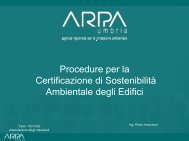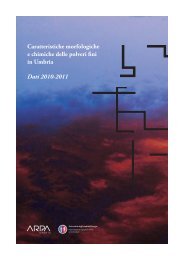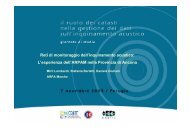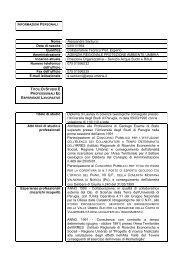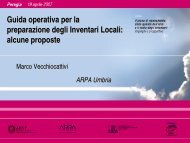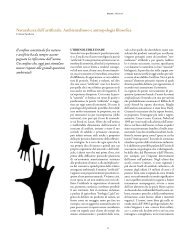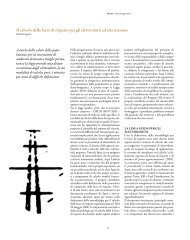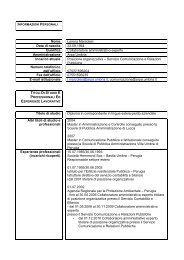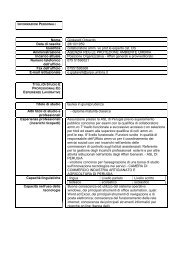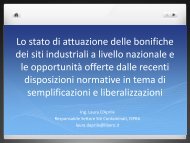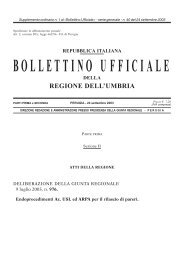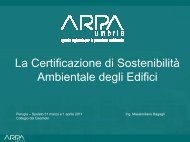Tutela ambientale del Lago Trasimeno - ARPA Umbria
Tutela ambientale del Lago Trasimeno - ARPA Umbria
Tutela ambientale del Lago Trasimeno - ARPA Umbria
Create successful ePaper yourself
Turn your PDF publications into a flip-book with our unique Google optimized e-Paper software.
2 8 6 A r p a U m b r i a 2 0 1 2<br />
Sembrerebbe logico, pertanto, indirizzare<br />
le azioni verso una riqualificazione<br />
degli alvei, allargandoli e rinaturalizzandoli<br />
ove possibile, dotandoli di<br />
casse di espansione, pensando, casomai,<br />
anche a forme di contenimento integrate<br />
con le tecniche di biomanipolazione<br />
(sistemi di avandighe filtranti davanti ai<br />
fossi, ove concentrare le azioni di dragaggio<br />
dei sedimenti grossolani).<br />
E quando il dragaggio diventa<br />
“obbligato” nel lago (porti e darsene),<br />
pianificarlo con sistemi che limitano la<br />
zona d’intervento, ad esempio palancolate<br />
o barriere galleggianti, adottando in<br />
ogni caso le tecniche meno impattanti<br />
(draghe pneumatiche).<br />
Dato per scontato l’obbligo di un<br />
effettivo abbattimento dei carichi esterni<br />
agro-zootecnici e civili (semplice attuazione<br />
<strong>del</strong>le misure già presenti nei piani<br />
di settore), è opportuno sottolineare<br />
che il lago ha bisogno di una gestione<br />
e di interventi ponderati, adattati alle<br />
singole specificità, talora di non interventi,<br />
ma tutto nel segno di una limitazioni<br />
<strong>del</strong>le azioni controindicate.<br />
Il che vuol dire: valutazione accurata,<br />
confronto pluridisciplinare tra esperti,<br />
partecipazione pubblica alle decisioni,<br />
senza demandare o arrogare ruoli non<br />
propri, coinvolgimento e valorizzazione<br />
<strong>del</strong>le conoscenze locali e <strong>del</strong>la comunità<br />
scientifica locale.<br />
Intervenire in modo tecnicamente<br />
corretto nella gestione <strong>del</strong>la vegetazione<br />
e <strong>del</strong> canneto, lavorare alla fissazione dei<br />
sedimenti (e dei nutrienti) con soluzioni<br />
a basso costo, quali la ricolonizzazione<br />
<strong>del</strong> fondale con macrofite, adottare<br />
approcci di biomanipolazione a larga<br />
scala (fauna ittica) o testando interventi<br />
localizzati a supporto <strong>del</strong>la vocazione<br />
turistica <strong>del</strong> lago (enclosure davanti alle<br />
spiagge), sono prospettive auspicate che<br />
hanno il vantaggio di essere poco invasive<br />
e valutabili in corso d’opera.<br />
It would seem logical, therefore, to<br />
direct intervention into a landscaping<br />
of the river beds, widening them and<br />
re-naturalising them where possible,<br />
providing them with retention basin,<br />
possibly even introducing methods of<br />
containment integrated with biomanipulation<br />
techniques (systems with filtration<br />
cofferdams in front of ditches,<br />
in which to concentrate dredging of the<br />
coarser sediments.)<br />
When dredging of the lake becomes<br />
an absolute necessity (ports and<br />
docks), it should be planned that this be<br />
done with systems which limit the area<br />
of intervention, eg. sheet piles or floating<br />
barriers, adopting in all cases the<br />
techniques which have less of an impact<br />
(pneumatic dredgers).<br />
On top of the clear obligation for<br />
an effective cutting of agro-zootechnical<br />
and civil loads (requiring simple<br />
implementing of the measures already<br />
planned for this), it is important to<br />
underline that the lake needs careful<br />
management and intervention, customised<br />
to the features of each specific<br />
case. Sometimes it may even be decided<br />
not to intervene, the aim being to avoid<br />
inappropriate intervention.<br />
What is needed is careful evaluation,<br />
multidisciplinary collaboration between<br />
experts, involvement of the public in<br />
decision making, without <strong>del</strong>egating or<br />
assuming roles inappropriately, exploitation<br />
of local knowledge and involvement<br />
of local scientists.<br />
The prospects hoped for have the<br />
advantages of being non-invasive and<br />
assessable while in progress, and are<br />
as follows: to intervene with technical<br />
accuracy in the management of the<br />
vegetation and the reed bed; to work<br />
on fixation of the sediments (and<br />
nutrients) with low cost techniques,<br />
such as re-colonisation of the lake floor<br />
with macrophytes; to adopt a large scale



